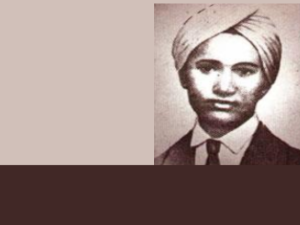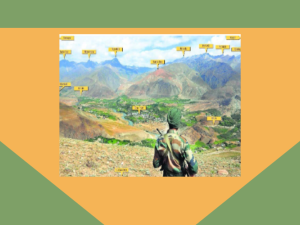The book Selections from Guru Nanak Bani by Dr. Dharam Singh and Dr. Paramvir Singh, published by the Shiromani Gurdwara Parbandhak Committee, has been put into question because of its translation and romanization. The point raised is that Gurbani is originally in Gurmukhi and should not be romanized. It is important to know the background of the translation and romanizing of Sri Guru Granth Sahib and other scriptures in the world.
The Guru Granth Sahib is the main holy religious scripture of Sikhism, regarded by Sikhs as the final, sovereign, and eternal Guru, following the lineage of the ten human gurus of the religion. The text consists of 1,430 angs (pages) and 5,894 shabads (line compositions), which are poetically rendered and set to a rhythmic ancient North Indian classical form of music. (1) The bulk of the scripture is divided into 31 main ragas, with each Granth raga subdivided according to length and author. The hymns in the Bible are organized primarily by the ragas in which they are read. (2) The Guru Granth Sahib is written in the Gurmukhi script in various languages, including Lahnda (Western Punjabi), Braj Bhasha, Kauravi, Sanskrit, Sindhi, Marathi, and Persian. Copies in these languages often have the generic title of Sant Bhasha. (3) The vision in the Guru Granth Sahib is of a society based on divine freedom, mercy, love, and justice without oppression of any kind. (4) (5)
In 1708, Guru Gobind Singh conferred the title of "Guru of the Sikhs" upon the Adi Granth. The event was recorded in a Bhatt Vahi (a bard's scroll) by an eyewitness, Narbud Singh, who was a bard at the Rajput rulers' court associated with gurus. (6) Sikhs since then have accepted the Guru Granth Sahib, the sacred scripture, as their eternal-living guru, as the embodiment of the ten Sikh Gurus, the highest religious and spiritual guide for Sikhs. It plays a central role in guiding the Sikh way of life. (7) (8)
Translations
Since the store of knowledge needs to be spread globally, translation is one of the important ways to spread it to those whose languages are different other than the languages the scripture is written. According to Ethnologue, there are currently 7,106 living languages in the world. Scholars generally recognize three languages as original biblical languages: Hebrew, Aramaic, and Koine Greek. As of 2020, the full Bible has been translated into 704 languages. The New Testament has been translated into 1,551 languages and parts of the Bible have been translated into 1,160 additional languages. The 12 Verse Challenge movement is dedicated to eradicating Bible poverty by the year 2033. (9) Quran originally written in Arabic language has been translated into 114 languages. (10)
Translations
Because the store of knowledge must be distributed globally, translation is an important means of reaching those whose languages differ from those in which the script is written. According to Ethnologue, there are currently 7,106 living languages in the world. Scholars generally recognise three languages as the original biblical languages: Hebrew, Aramaic, and Koine Greek. As of 2020, the full Bible has been translated into 704 languages. The New Testament has been translated into 1,551 languages, and parts of the Bible have been translated into 1,160 additional languages. The 12 Verse Challenge movement is dedicated to eradicating Bible poverty by the year 2033. (9) Quran, originally written in the Arabic language, has been translated into 114 languages. (10)
Max Arthur Macauliffe, a British civil servant, was next to publish a major but incomplete translation of the Guru Granth Sahib, covering the same ground as Trumpp but interspersing his translation between Janamsakhis-based mythical history of the Sikh Gurus.(15)(16) Suraj Prakash of Santokh Singh was a major source of historical information for him, and his primary translation advisor was the prominent Khalsa Sikh scholar Kahn Singh Nabha—author of Gurmat Prabhakar and Hum Hindu Nahin. (17) (18) Macauliffe's translation appeared embedded in the six-volume The Sikh Religion and was published by Oxford University Press in 1909. (16) Unlike Trump, who ignored Sikh sensibilities and empathy, Macauliffe used his editorial creativity to incorporate these sensibilities. (16) A major source of his historical information was Suraj Prakash of Santokh Singh, and his primary translation advisor was the prominent Khalsa Sikh scholar Kahn Singh Nabha – the author of Gurmat Prabhakar and Hum Hindu Nahin. (17)(18) Mcauliffe's translation appeared embedded in the six-volume The Sikh Religion and was published by Oxford University Press in 1909. (16) Unlike Trump who had disregarded the sensibilities and empathy for the Sikhs, Macauliffe used his creative editorial abilities to incorporate these sensibilities.(16) While Trump criticized Sikhism and the Guru Granth Sahib, McAuliffe criticized Hinduism and wrote an introduction that presented the hymns of Sikh Gurus as Christian-like with affinities to "Protestant virtues and ethics", presumably for a British audience, states Indologist Giorgio Shani.(19) McAuliffe's translation was well received by the Sikh community and considered by them as closer to how they interpret their scripture.(16) Post-colonial scholarship has questioned McAuliffe's accounting for and incorporation of Sikh traditions as "uncritical" and "dubious", though one that pleased the Sikh community.(16) McAuliffe's version has been widely followed by later scholars and translators.
According to Christopher Shackle – a scholar of Languages and Religion, McAuliffe's approach to translation was to work with Khalsa Sikh reformists of the 1890s (Singh Sabha) and exegetically present the scripture in a "progressive monotheism" fold that deserved the support of the British administration as a distinct tradition, and of the native Sikh clergy.(14) He used considerable freedom in restating the archaic poetry into a "vaguely psalm-like translation" (20) The first complete English translation of the Guru Granth Sahib, by Gopal Singh, was published in 1960. A revised version published in 1978 removed archaic English words such as "thee" and "thou". In 1962, an eight-volume translation into English and Punjabi by Manmohan Singh was published by the Shiromani Gurdwara Parbandhak Committee. In the 2000s, a translation by Sant Singh Khalsa appeared on major Sikhism-related websites such as 3HO/Sikh Dharma Brotherhood's Sikhnet.com.(21) It has also included the romanization of Sri Guru Granth Sahib.https://sggsonline.com/ team (22) extended the translation scope of Sri Guru Granth Sahib to other Indian and foreign languages. Accordingly, besides Punjabi & English, other languages where the translation work is either complete or in active progress, are Hindi, Marathi, Gujarati, Tamil, Telugu, Odia, Urdu, Urdu Master, Urdu Raw, Bengali, Thai, Arabic, Persian, Malaysian, Russian, and French. (23). Considering the importance of translation of Sri Guru Granth Sahib, a University set at Bulandpur near Nakodar aims to translate Sri Guru Granth Sahib in all major languges of the world.
Apart from translations in English, translations into other languages have been also going on. Since the Gurbani was recited, written, and compiled for the entire universe and spread by the Gurus visiting globally, it needs to reach all over the world.
Romanisation
Since English is the most globally recognized language even English romanization of these scriptures has been done
The Holy Qur'an- Arabic and English text, along with romanized text for pronouncing the Arabic, along with commentaries and Notes to give depth of understanding published by Abdullah Yusuf Ali (24) and many others similarly Sri Guru Granth Sahib also has been Romanised. Full romanized versions are available at https://archive.org/details/SriGuruGranthSahibJi-InGurmukhiRomanisedEnglish,(25) https://www.punjabonline.com/translations/Siri Guru Granth Sahib, Romanized.pdf (26) by Kulbir Singh Thind Siri Guru Granth Sahib, Romanized on Sri.Granth. org. Romanized versions of Gurbani are also available. Various authors have used Romanised versions in books like Guru Nanak's Japuji by Madan G Gandhi. (27)
It is thus very important that the knowledge of Sri Guru Granth Granth Sahib is spread worldwide. For this, translation and Romanisation of the scripture are essential. Since the book in question has used a romanized version as already exists in Kulbir Singh Thind's SriGranth.org and accepted by SGPC, raising such questions does not appear valid.
References
(1) Anna S. King and JL Brockington (2005), The Intimate Other: Love Divine in Indic Religions, Orient Blackswan, ISBN 978-8125028017, pages 359-361
(2) Christopher Shackle and Arvind Mandair (2005), Teachings of the Sikh Gurus, Routledge, ISBN 978-0415266048, pages xvii-xx
(3) Harnik Deol, Religion and Nationalism in India. Routledge, 2000. ISBN 0-415-20108-X, 9780415201087. Page 22. "(...) the compositions in the Sikh holy book, Adi Granth, are a melange of various dialects, often coalesced under the generic title of Sant Bhasha."
The Making of Sikh Scripture by Gurinder Singh Mann. Published by Oxford University Press US, 2001. ISBN 0-19-513024-3, ISBN 978-0-19-513024-9 Page 5. "The language of the hymns recorded in the Adi Granth has been called Sant Bhasha, a kind of lingua franca used by the medieval saint-poets of northern India. But the broad range of contributors to the text produced a complex mix of regional dialects."
Surinder Singh Kohli, History of Punjabi Literature. Page 48. National Book, 1993. ISBN 81-7116-141-3, ISBN 978-81-7116-141-6. "When we go through the hymns and compositions of the Guru written in Sant Bhasha (saint-language), it appears that some Indian saint of 16th century...."
Nirmal Dass, Songs of the Saints from the Adi Granth. SUNY Press, 2000. ISBN 0-7914-4683-2, ISBN 978-0-7914-4683-6. Page 13. "Any attempt at translating songs from the Adi Granth certainly involves working not with one language, but several, along with dialectical differences. The languages used by the saints range from Sanskrit; regional Prakrits; western, eastern, and southern Apabhramsa; and Sahiskriti. More particularly, we find sant bhasha, Marathi, Old Hindi, central and Lehndi Panjabi, and Persian. There are also many dialects deployed, such as Purbi Marwari, Bangru, Dakhni, Malwai, and Awadhi."
(4) Torkel Brekke (2014), Religion, War, and Ethics: A Sourcebook of Textual Traditions (Editors: Gregory M. Reichberg and Henrik Syse), Cambridge University Press, ISBN 978-0521450386, pages 673, 675, 672-686
(5) 11. Christopher Shackle and Arvind Mandair (2005), Teachings of the Sikh Gurus, Routledge, ISBN 978-0415266048, pages xxxiv-xli
(6) Singh, Gurbachan; Sondeep Shankar (1998). The Sikhs : Faith, Philosophy and Folks. Roli & Janssen. p. 55. ISBN 81-7436-037-9.
(7) Adi Granth, Encyclopaedia Britannica
(8) Pashaura Singh (2000). The Guru Granth Sahib: Canon, Meaning and Authority. Oxford University Press. pp. 271–275. ISBN 978-0-19-564894-2
(9) For more information about the 12 Verse Challenge visit illumiNations 12 Verse Challenge.
(10) [email protected] (Nabeel A. Rana)
(11) The Adi Granth, Ernest Trumpp (1877), WH Allen & Co., London; Notes: In this 876 pages publication, Trump's translation starts at page 156, while philological notes on the language of the Sikh scripture start at page 140
(12) Trilochan Singh (1994). Ernest Trumpp and W.H. McLeod as scholars of Sikh history religion and culture. International Centre of Sikh Studies. pp. xv–xvii, 45–49.
(13) Arvind-Pal Singh Mandair (2013). Sikhism: A Guide for the Perplexed. Bloomsburg Academic. pp. 86–87. ISBN 978-1-4411-0231-7.
(14) Akshaya Kumar (2014). Poetry, Politics, and Culture: Essays on Indian Texts and Contexts. Routledge. pp. 167–168. ISBN 978-1-317-80963-0.
(15) Donald Dawe (2011), Macauliffe, Max Arthur, Encyclopedia of Sikhism, Volume III, Harbans Singh (Editor), Punjabi University, Patiala; The translation of Guru Nanak's Janamsakhi and his hymns in the Guru Granth Sahib are in McAuliffe's Volume I, The Sikh Religion (1909)
(16) JS Grewal (1993). John Stratton Hawley; Gurinder Singh Mann (eds.). Studying the Sikhs: Issues for North America. SUNY Press. pp. 164–165. ISBN 978-0-7914-1425-5.
(17) Arvind-Pal Singh Mandair (2013). Sikhism: A Guide for the Perplexed. A&C Black. pp. 85–89. ISBN 978-1-4411-0231-7.
(18) Jones, Kenneth W. (1973). "Ham Hindū Nahīn: Arya Sikh Relations, 1877–1905". The Journal of Asian Studies. Cambridge University Press. 32 (3): 457–475. doi:10.2307/2052684. JSTOR 2052684. S2CID 163885354.
(19) Giorgio Shani (2007). Sikh Nationalism and Identity in a Global Age. Routledge. pp. 30–31. ISBN 978-1-134-10189-4.
(20) Christopher Shackle (2005). Lynne Long (ed.). Translation and Religion. Multilingual Matters. pp. 50–51. ISBN 978-1-84769-550-5.
(21) 3HO/Sikh Dharma Brotherhood's Sikhnet.com
(22) Guru Granth Sahib Translation Project – sggsonline team
(23) SGGS.online California
(24)The Holy Qur'an- Arabic and English text, along with romanised text for pronouncing the Arabic, along with commentaries and Notes to give depth of understanding: Abdullah Yusuf Ali: 9788171512522: Amazon.com: Books
(25) Sri Guru Granth Sahib Ji - in gurmukhi & romanised & english : www.DiscoverSikhism.com : Free Download, Borrow, and Streaming : Internet Archive,
(26)https://www.punjabonline.com/translations/Siri Guru Granth Sahib, Romanized.pdf.
(27) Guru Nanak's Japuji, The Celestial Ladder by Madan G Gandhi. Earth Vision Publications Gurgaon, 2010





